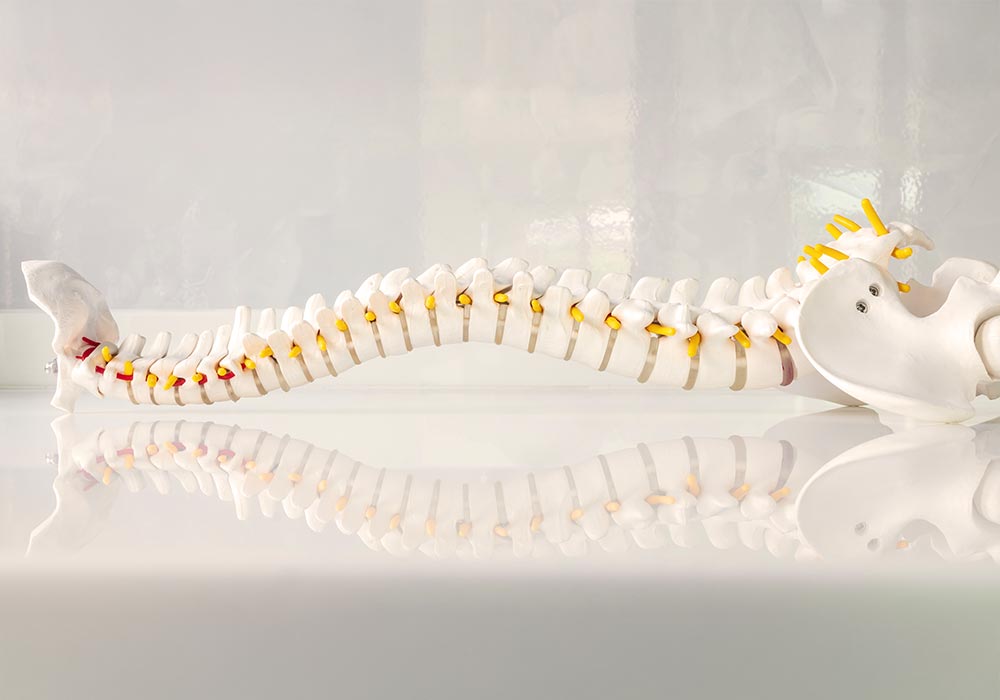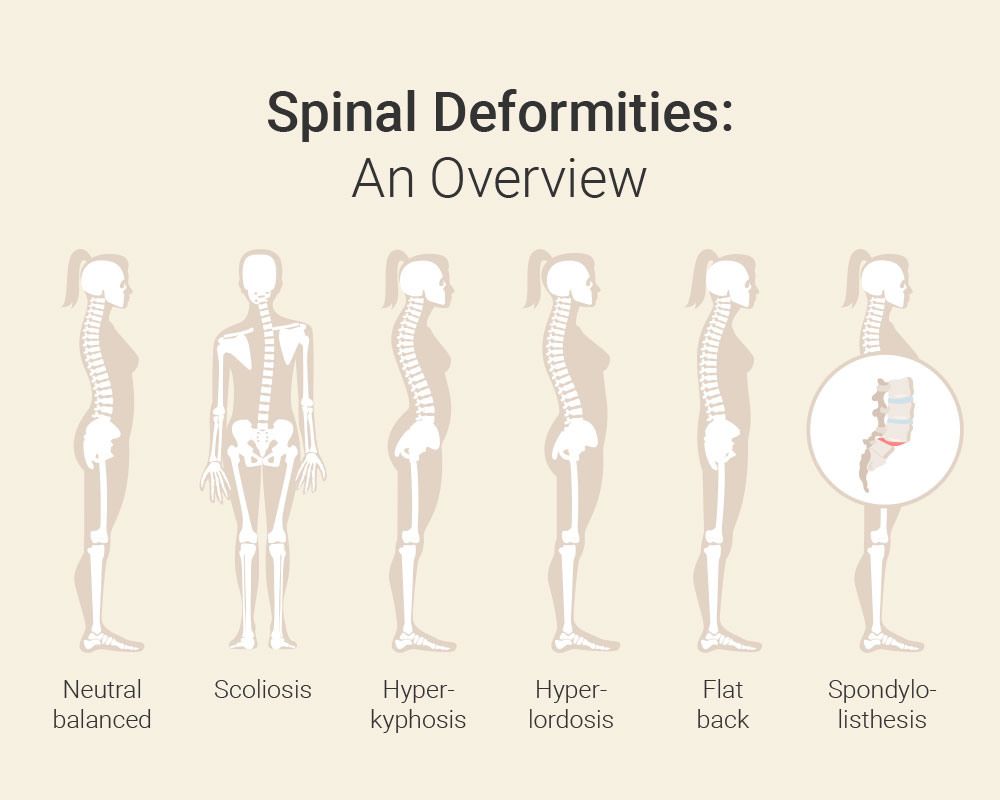Back pain, poor posture or restricted movement – many of these complaints are caused by structural changes in the spine. Particularly when individual sections deviate permanently from their natural shape, this can not only affect the statics of the body, but also lead to serious health problems in the long term. Below you can find out what form deviations can occur, how you can recognize them and how we can help.

About the healthy spine
The spine is the central supporting element of the human skeleton and connects the head to the pelvis. It consists of 24 movable vertebrae (cervical, thoracic and lumbar vertebrae), the sacrum and the coccyx. There are intervertebral discs between the vertebrae, which act as a buffer and provide mobility and shock absorption. Together with ligaments, muscles and nerves, the spine fulfills several important functions: It supports the body, protects the spinal cord and enables a variety of movements.
A healthy spine has a double S-shape when viewed from the side. This natural curve consists of a gentle cervical lordosis (curved forwards), a slight thoracic kyphosis (curved backwards) and a gentle lumbar lordosis (curved forwards again). This shape ensures an even distribution of loads and gives the spine stability and elasticity. Viewed from the front, the spine should be straight.
Spinal deformity: what is it?
The term spinal deformity refers to a permanent misalignment or curvature of the spine in which the natural shape deviates significantly from the norm. Such deformities can be congenital or develop over the course of a lifetime – e.g. due to growth disorders, illnesses, accidents or degenerative processes such as wear and tear.
Such changes in shape can not only affect the external appearance, but can also cause pain, restrict mobility and, in advanced stages, affect organs.
Spinal deformity: these forms exist
Scoliosis
Scoliosis is a permanent lateral curvature of the spine, in which there is also usually a twisting (rotation) of the vertebral bodies around their own axis. Instead of a straight line, the spine in scoliosis – especially when viewed from behind – shows a more pronounced S- or C-shaped deviation.
This deformity can have different causes: In most cases, it is idiopathic, meaning that the exact trigger is unknown. It often occurs in childhood or adolescence during growth. Other possible causes are congenital malformations of the vertebrae (congenital scoliosis), neuromuscular diseases (e.g. muscular dystrophy) or degenerative changes in old age.
Mild scoliosis often causes no symptoms. However, more severe curvatures can cause back pain, muscle tension, restricted mobility or, in advanced stages, even impairments of the internal organs (e.g. lungs or heart). Treatment depends on the degree of severity and ranges from regular observation and physiotherapy to brace treatment or surgical correction.
Hyperkyphosis
There is a natural gentle curve in the thoracic spine. In some cases, however, this natural curve is excessively pronounced. This is known as hyperkyphosis – popularly known as a “hunchback” or “widow’s hump”.
Excessive kyphosis can have various causes: In young people, Scheuermann’s disease – a growth disorder of the vertebral bodies – is often responsible. In older people, hyperkyphosis often occurs as a result of vertebral fractures caused by osteoporosis. Poor posture, muscle weakness or neurological diseases can also contribute to its development.
Typical signs are a forward leaning upper body, tension in the shoulder/neck area and back pain. In severe cases, the body statics can be significantly disturbed, which can affect breathing and organ function.
Treatment depends on the cause and extent of the curvature. It ranges from physiotherapeutic exercises to improve posture to brace treatment or surgery in cases of very advanced hyperkyphosis.
Hyperlordosis
This is an excessive curvature of the spine in the area of the lumbar spine. This so-called “hollow back” posture deviates significantly from the natural S-shape of the spine and can lead to incorrect strain on the back.
Hyperlordosis is often caused by muscular imbalances – for example, if the abdominal muscles are weakened and the hip flexor muscles are shortened. Obesity, pregnancy, prolonged sitting, incorrect posture or underlying orthopaedic conditions can also contribute to its development. In some cases, hyperlordosis occurs as compensation for other deformities, e.g. pronounced kyphosis.
Typical symptoms are tension in the lower back, pain when standing or walking for long periods and a conspicuous posture with the pelvis tilted forward. Treatment usually involves targeted physiotherapy, postural exercises and muscular training – in severe cases, surgery may also be necessary.
Flat back
A flat back is a postural abnormality in which the natural curves of the spine – particularly in the area of the lumbar lordosis and thoracic kyphosis – are significantly flattened or even eliminated. Instead of the typical S-shape, the spine appears almost straight when viewed from the side.
This altered statics means that the spine loses its actual shock-absorbing function. As a result, it is less able to absorb shocks, which can lead to back pain, tension and increased strain on the intervertebral discs. The mobility of the back is also often restricted.
A flat back can be congenital or acquired – for example due to poor posture, muscular imbalances, spinal surgery or diseases such as ankylosing spondylitis. People who sit for long periods, move little or permanently adopt a cramped, upright posture are particularly affected.
Treatment usually involves physiotherapy exercises that promote the natural curvature of the spine and strengthen the back muscles in a targeted manner. In severe cases, surgical treatment may also be necessary.
Spondylolisthesis
Spondylolisthesis is a disease of the spine in which a vertebral body slips forwards or – more rarely – backwards in relation to the vertebral body below it. This displacement can impair the stability of the spine and constrict nerve structures. A distinction is made between different forms depending on the cause:
- Isthmic spondylolisthesis
This is often caused by a defect or fracture in the so-called pars interarticularis, usually in the area of the lumbar spine. Athletically active young people are frequently affected. - Degenerative spondylolisthesis
In this case, older people in particular are affected. The spondylolisthesis is a result of wear and tear on the intervertebral discs and small vertebral joints. - Congenital spondylolisthesis
This is due to a malformation of the vertebral arches. - Traumatic or pathological forms
Spondylolisthesis is caused by injuries, tumors or other underlying diseases.
Typical symptoms are deep-seated back pain, which worsens with movement, as well as occasional pain radiating to the buttocks or legs if nerves are affected. In advanced cases, numbness or muscle weakness may occur.
Treatment depends on the degree of severity: in many cases, physiotherapy, back training and pain therapy can help. In cases of severe spondylolisthesis or neurological deficits, surgical stabilization may be necessary.
Combined deformities
It is also possible for several spinal deformities to occur simultaneously, which reinforce or compensate for each other. A typical example is the combination of scoliosis and hyperkyphosis or hyperlordosis. In such cases, the spine is not only curved sideways, but also shows an excessive forward or backward curvature – often with an additional twisting of the vertebral bodies.
These complex changes can severely impair posture and often lead to muscular imbalances, back pain, restricted mobility and, in severe cases, impaired breathing or other internal organs. The cause of combined deformities can be congenital, due to growth disorders or caused by wear and tear, osteoporosis, surgery or neurological diseases over the course of a lifetime.
As every combined deformity is unique, precise diagnostic clarification is crucial – usually using imaging techniques such as X-ray or MRI. Therapy often requires an interdisciplinary approach which, depending on the extent, consists of physiotherapy, orthopaedic treatment with a brace or, in severe cases, surgical intervention for correction and stabilization. The aim is to alleviate discomfort, improve function and prevent the deformity from progressing.

Treating spinal deformity: Advanced therapies with Dr. Tabrizi in Frankfurt
Spinal deformities such as scoliosis, hyperkyphosis, hyperlordosis or spondylolisthesis can cause considerable discomfort in everyday life. In addition to back pain and tension, many sufferers experience restricted movement, postural problems or neurological symptoms such as tingling or numbness.
At our private practice for orthopaedics and traumatology in Frankfurt, we specialize in holistic spinal therapies, among other things. In addition to traditional orthopaedic care, we offer a range of complementary therapeutic approaches to specifically relieve your pain and improve the function of your spine. These include:
- Neural therapy / segment therapy
We can relieve pain and activate your self-healing powers through targeted injections of local anaesthetics into pain-triggering areas or associated skin segments. - Infiltrations near the spine
We can treat inflammation in small vertebral joints or nerve roots with targeted injections. This reduces pain and improves mobility. - CT- or MRI-guided infiltrations (PRT, epidural)
Under imaging control, anti-inflammatory medication is injected precisely into affected nerve roots or disc changes to relieve pain. - Chiropractic therapy
We use special manual techniques to release blockages and improve the mobility of your spine. Chirotherapy is often very helpful, especially in the case of functional restrictions. - Traction treatments
Gentle longitudinal traction in combination with the application of heat can release tension and relieve the spine, which can be particularly beneficial in the case of degenerative changes. - Infusion therapies
If necessary, we can administer pain-relieving or muscle-relaxing medication intravenously to achieve a rapid and consistent effect. - Kinesio taping
Elastic tapes, which we systematically attach to your skin, support your muscles, promote blood circulation and can reduce pain. - Acupuncture
By inserting fine needles at specific points, we can influence pain conduction and promote muscle relaxation, which supports the treatment of chronic back pain.
Help with a spinal deformity: Dr. Tabrizi in Frankfurt
Anyone suffering from a spinal deformity not only needs a precise diagnosis, but above all individual and holistic treatment. Patients with spinal deformities are in the best hands at our orthopaedic practice in Frankfurt.
We combine many years of experience in spinal medicine with modern therapy methods and a holistic treatment approach. The aim is to alleviate pain, maintain or restore mobility and improve quality of life in the long term – without having to operate prematurely. To achieve this, we have a variety of procedures available, which we combine individually and tailor to the respective complaints.
Please contact us to arrange an appointment!
609198784 © Issara | 901451029 © VectorMine | 594712837 © inspiring.team | stock.adobe.com